IOMeter and HD Tach performance
On now to IOMeter and HD Tach.
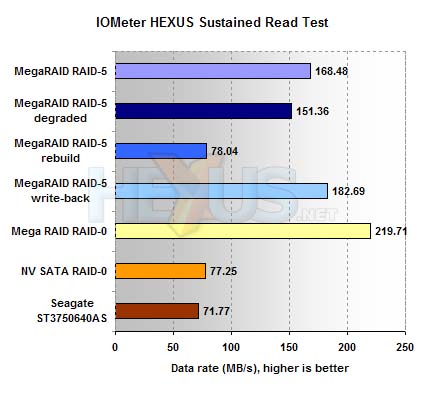
Let's start by analysing the bottom two graph results. In our tests, a single 750GB SATA drive came close to performing as quickly as two 250GB SATA drives. Perpendicular storage isn't just capacious, it's quick too.
Four 750GB disks in RAID-0 perform the best. Our tweaked RAID-5 config comes up close too, thanks to read-ahead, we reckon. The unmolested RAID-5 configuration comes in third, still pumping through nearly 170MB/s. Even when the array is degraded, the missing data can be reconstituted quickly from parity data, resulting in a drop of less than 20MB/s. It's when a rebuild is taking place that throughput takes a hit, dropping down to almost the speed of a single disk.
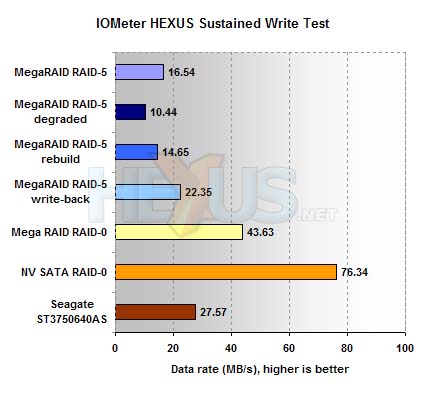
The tables seem to turn in our write tests. We found the write performance of Seagate's 750GB drives to be a bit below par compared to the older 250GB models, for which read/writes were about the same. The ST3750640AS could only manage a write speed just over a third of its read speed. This was reflected and amplified by the RAID card, which, in our IOMeter tests, didn't break 25MB/s, even with write caching enabled in RAID-5. There's quite a boost to performance with the MegaRAID set to RAID-0, suggesting that RAID-5 parity calculations might be holding things up.
Throwing a few numbers around, if RAID-0 performance on four disks is 43MB/s, then in RAID-5, take away one disk (that's going to have parity, not data, written to it) and we're left with ~32MB/s. There's then another 10MB/s lost... by the parity computation? It's never as simple as that, but it gives us a rough idea of how data rates are being affected.
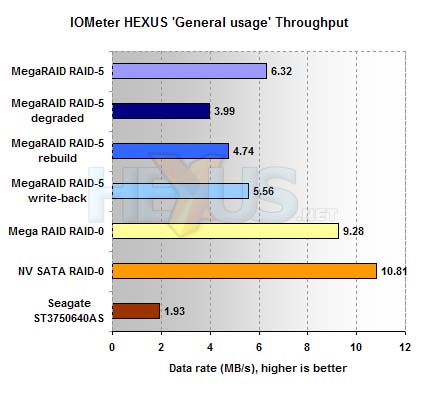
If you recall our i-RAM review, we found out how woefully slow disks are at this particular test of ours. Once again the 750GB SATA drive seems to slow right down. The MegaRAID level-5 array copes a lot better than a single disk, same with level-0, but the winner is still just two 250GB disks in simple NV RAID-0.
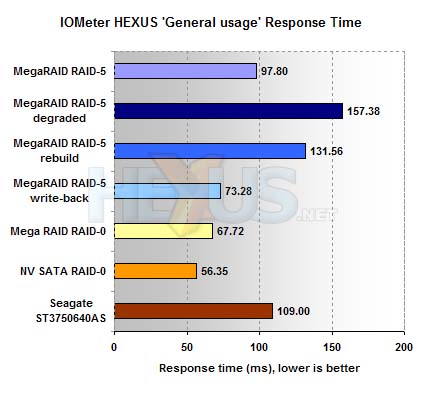
With caching and read-ahead on the MegaRAID's response times are cut quite a bit. Again we found the ST3750640AS's response time to be quite high. The MegaRAID cuts back on response times, especially with write-back caching, but NV RAID still wins.
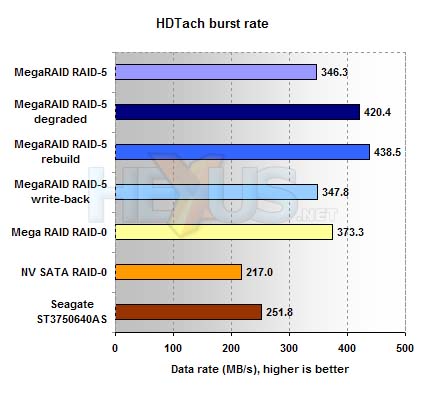
Burst speeds for reading from the disks and arrays proved quite interesting. The NV RAID-0 array comes in last, with a single 750GB SATA drive managing to beat it, taking up a good share of its 3Gbps interface. The x8 PCIe interface isn't getting close to maxed out by any means, but burst rates are still mighty high. What's most interesting is that we got higher burst rates with a 'knackered' RAID array. Yes, degraded and rebuilding got the highest scores.
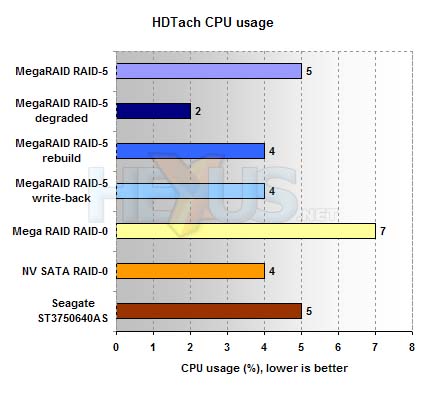
The MegaRAID in RAID-0 takes up the most CPU usage in our tests. Bear in mind that this is configuration that was capable of the greatest read throughput, so increased CPU usage is going to be a by-product of this.
5% usage was found for writing to a single disk, or the online RAID-5 array, so RAID-5 doesn't appear to give a CPU hit. We'd expect this from a card like this. As the data rate drops (with a degraded array) so too does the CPU usage. These results are only integer accurate, so they can't be taken as too precise.
We spent a fair amount of time destroying and rebuilding arrays while testing, making various changes and doing many test runs before we settled on these results. We tried as much as we could to get high write speeds on the MegaRAID. Putting the disks into 3Gbps mode (via the jumper mentioned earlier in this review) helped. We were running the latest firmware and drivers at the time of writing. We can't see evidence of any compatibility issues, so all we can say is that our tests showed somewhat disappointing write speeds from the MegaRAID 8408E. We will concede that the board we used for testing isn't a workstation/server board, so we could well have introduced the card to a board it has never before been tested in. In other departments, however, the array and its controller do rather well.









